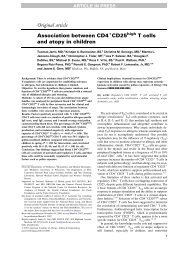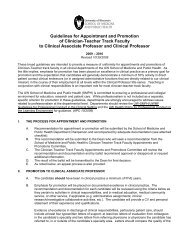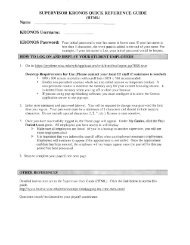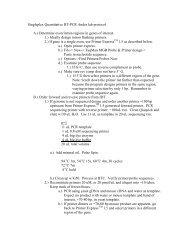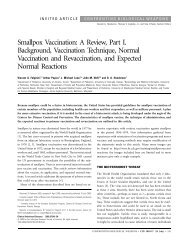Not Crying Wolf
Not Crying Wolf
Not Crying Wolf
You also want an ePaper? Increase the reach of your titles
YUMPU automatically turns print PDFs into web optimized ePapers that Google loves.
Alexis Eastman<br />
PGY‐3<br />
Internal Medicine<br />
(No financial relationships to disclose, just student loans)
The Mysterious Lump<br />
• 56 year‐old female with SLE, DM2 with<br />
proteinuria, PHTN, on hydroxychloroquine<br />
and prednisone<br />
• Two weeks with new 1.5 cm right forearm<br />
mass<br />
• No constitutional symptoms, no other skin<br />
changes
Exam<br />
• Firm, freely mobile 1.5 cm mass on right<br />
volar forearm<br />
• Mildly tender to palpation, no overlying<br />
skin changes, no fluctuance or drainage<br />
• Remainder of exam unremarkable
One week later<br />
• Returned to clinic with a 2.5 cm mass, now<br />
with mild overlying erythema<br />
• WBC 4.6 k/uL, Hb 10.5 g/dL, Plts 337k/uL<br />
Thomas Ray, Univ of IA Dept of Dermatology, Hardin MD, Univ of IA<br />
http://hardinmd.lib.uiowa.edu/ui/tray/LE‐profund‐005.html
Ultrasound<br />
• Subcutaneous edema and fat lobules with<br />
increased flow, concern for infection,<br />
malignancy, early post‐traumatic ossification
And so it grows…<br />
• Over the next two weeks, increased to 4 cm<br />
• Increased tenderness, moderate erythema<br />
• Patient endorsed fevers (unmeasured) and<br />
fatigue but no night sweats or chills
Differential<br />
• Infectious panniculitis<br />
• Insect‐bite panniculitis<br />
• Abscess<br />
• Malignancy, particularly cutaneous lymphoma<br />
• Lipoma<br />
• Neurofibroma<br />
• Trauma with ossification or keloid<br />
• Cutaneous lupus
Nervousness ensues<br />
• MRI obtained: No Abscess (whew!)<br />
• Biopsy: cultures negative
Tissue is the issue….<br />
• Histopathology: dense lymphoplasmacytic<br />
infiltrate of the dermis extending into the<br />
subcutis with rare vessels showing fibrinoid<br />
necrosis. Lymphoid infiltrate composed of<br />
small lymphocytes and immunoblasts, with<br />
morphologically unremarkable plasma cells.<br />
• Most consistent with
Histology<br />
microcalcification<br />
Follicular plugging<br />
peripheral nerve with<br />
lymphocytic infiltration<br />
Basement membrane<br />
hyalinization<br />
Lymphocytic vasculitis<br />
Lobular lymphocytic infiltrate<br />
with septal karyorrhexis<br />
(Thanks, Dad)
Lupus Erythematosus Profundus<br />
• Cutaneous lupus without systemic disease: 3/100,000<br />
• Similar to prevalence of SLE<br />
• Majority is Chronic cutaneous lupus (CCLE)<br />
• Lupus erythematosus profundus is a subtype<br />
• Usually independent of SLE (10‐42% of cases)<br />
• Only 1‐5% of patients with pre‐existing SLE will develop LEP<br />
• 2‐9:1 female:male ratio, median age of onset in the<br />
mid‐40s
Presentation<br />
• Nodules<br />
• Tender, subcutaneous<br />
• Asymmetric on face, proximal upper extremities, trunk<br />
• Very rarely on lower extremities<br />
• In African‐Americans or Asians may be periorbital or salivary<br />
• Overlying erythema is common<br />
• Concomitant discoid lupus<br />
• Relapsing‐remitting course<br />
• Lesions resolve with significant lipoatrophy<br />
and permanent skin depressions
Diagnosis<br />
• Labs are of little help<br />
• Usually ANA and anti‐dsDNA negative<br />
• Occasional lymphopenia, anemia, low C4, positive RF, positive anti‐cardiolipin<br />
• Biopsy is the gold standard, recently proposed criteria include:<br />
• Major:<br />
• Hyaline fat necrosis<br />
• Lymphocytic aggregates<br />
• Lymphoid follicle formation<br />
• Periseptal or lobular lymphocytic<br />
panniculitis<br />
• Microcalcifications<br />
• Minor:<br />
• Discoid lupus in overlying skin<br />
• Lymphocytic vasculitis<br />
• Subepidermal hyalinization<br />
• Mucin deposition<br />
• Histiocytes and small granulomas<br />
• Plasma cell or eosinophil<br />
infiltrates<br />
• Lymphoid follicles are particularly useful as they are not seen in<br />
lymphoma. Subcutaneous T‐cell lymphomas (STCL) can have significant<br />
overlap with LEP.
Treatment<br />
• Mainstay: anti‐malarials, primarily<br />
hydroxychloroquine<br />
• Approximately 60% of patients respond to treatment<br />
• Methotrexate can be added to refractory cases<br />
• Intralesional steroids not recommended<br />
• can increase the lipoatrophy upon healing
Prognosis<br />
• Nodules regress with atrophic changes<br />
• Can cause significant facial disfigurement<br />
• Frequently recurs:<br />
• 2010 retrospective case analysis, 76% of the patient<br />
experienced recurrence within 14 months after<br />
treatment finished<br />
• Progresses to systemic disease in 7‐50% of patients
Take Home Points<br />
• It can always be Lupus!<br />
• Always rule out malignancy and infection prior to treatment<br />
• One of the leading causes of death in SLE<br />
• Watch out for STCL and its overlap on pathology<br />
• Biopsy is the only way to accurately diagnose cutaneous lupus<br />
• Treatment consists of anti‐malarials, such as hydroxychloroquine, and/or<br />
methotrexate<br />
• Intralesional steroids should be avoided as they can increase lipoatrophy<br />
in the healing process<br />
• Patients without SLE need close follow‐up, as they are at increased risk<br />
of developing SLE
Further Reading<br />
• Fraga J and García‐Díez A. “Lupus erythematosus panniculitis,”<br />
Dermatology Clinics 2008; 26:453‐63.<br />
• Park HS, Choi JW, Kim BK, and Cho KH. “Lupus erythematosus<br />
panniculitis: clinopathological, immunophenotypic, and molecular<br />
studies,” American Journal of Dermatopathology 2010; 32(1):24‐30.<br />
• Obermoser G, Sontheimer RD, and Zelger B. “Overview of common,<br />
rare, and atypical manifestations of cutaneous lupus erythematosus<br />
and histopathological correlates,” Lupus 2010; 19:1050‐70.
Thanks!



